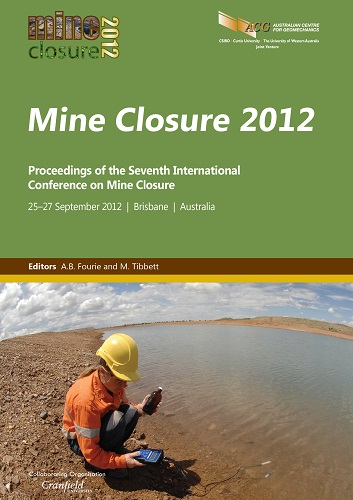Riparian classification to benchmark reclamation of the Athabasca oil sands

|
Authors: Daly, CA; Anderson, HB; Campbell, A; Kuzmic, F |
DOI https://doi.org/10.36487/ACG_rep/1208_51_Daly
Cite As:
Daly, CA, Anderson, HB, Campbell, A & Kuzmic, F 2012, 'Riparian classification to benchmark reclamation of the Athabasca oil sands', in AB Fourie & M Tibbett (eds), Mine Closure 2012: Proceedings of the Seventh International Conference on Mine Closure, Australian Centre for Geomechanics, Perth, pp. 597-608, https://doi.org/10.36487/ACG_rep/1208_51_Daly
Abstract:
A Riparian Classification and Reclamation Guide (‘Riparian Guide’) was recently produced to direct the re-establishment of riparian ecosystems in areas disturbed by oil sands mining in Alberta, Canada. The Riparian Guide presents information on the identification, characterisation, and implementation of revegetation and monitoring protocols on reclaimed landscapes within the oil sands region. The purpose of the guide was to provide a classification system and tools associated with plant species and community interactions that can be used to effectively reclaim and revegetate disturbed riparian ecosystems. The Riparian Guide thus provides a framework for interpreting the environmental conditions of sites to be reclaimed, plant species requirements, landscape design and management objectives to facilitate reclamation activities and aid in the re-establishment of plant communities that were representative of riparian vegetation. An overview of the process that led to the development of the Riparian Guide is presented, including monitoring and riparian classification system that formed the foundation of the guide, a species selection tool, and a peer review. Finally, the riparian species selection tool is tested in a field program and the preliminary results of this test are reviewed.
References:
AENV (2007) Alberta Environment. Riparian land conservation and management project: Phase I final report.
Beckingham, J.D. and Archibald, J.H. (1996) Field guide to ecosites of northern Alberta, UBC Press, Vancouver, British Colombia, Canada.
Calvo-Polanco, M., Senorans-Argibay, J., Equiza, A. and Zwiazek, J.J. (2012) Environmental constraints to growth of Rat Root (Acorus americanus), Canadian Oil Sands Network for Research and Development (CONRAD) Environmental Reclamation Research Group (ERRG) Annual Symposium, Edmonton, Alberta, January 30–31, 2012.
CEMA (2010) Cumulative Environmental Management Association. Guidelines for reclamation to forest vegetation in the Athabasca Oil Sands region, 2nd ed (Revegetation Manual), Prepared by the Terrestrial Subgroup of CEMA.
GDC (2009) Geographic Dynamics Corp. Riparian Classification and Reclamation Guide, developed for Shell Canada Energy and Suncor Energy Inc. by GDC, Edmonton, Alberta, Incremental Forest Technologies Ltd 2011, Riparian Classification and Reclamation Guide – Revised, developed for the Cumulative Environmental Management Association.
Golder (2005) Golder Associates Ltd. Consolidated Tailings (CT) Integrated Reclamation Landscape Demonstration Project Technical Report #5 – Year 2004, Phase 1 Final Report 2000 to 2004, prepared for Suncor Energy Inc Oil Sands.
Hammer, U.T. (1993) Zooplankton distribution and abundance in saline lakes in Alberta and Saskatchewan, Canada, International Journal of Salt Lake Research, Vol. 2 (2), pp. 111–132.
Harris, M.L. (2007) Guideline for wetland establishment on reclaimed oil sands leases (revised second edition), Prepared by Lorax Environmental for CEMA Wetlands and Aquatics Subgroup of the Reclamation Working Group, Fort McMurray, AB.
Jacobs, D.F. and Timmer, V.R. (2005) Fertilizer-induced changes in rhizosphere electrical conductivity: relation to forest tree seedling root system growth and function, New Forests, Vol. 30, pp. 147–166.
Johnson, D., Kershaw, L., MacKinnon, A. and Pojar, J. (2005) Plants of the western boreal forest and aspen parkland, Lone pine publishing and the Canadian Forest Service, p. 309, p. 312.
Korol, J.B. (1996) Riparian forest communities in the Southern Boreal Region of central Saskatchewan, Prince Albert Model Forest Association Inc., Prince Albert, Saskatchewan.
McCune, B. and Mefford, M.J. (1999) Multivariate analysis of ecological data, Version 4.14 PC-ORD for Windsors, MJM Software, Gleneden Beach, Oregon, USA.
OSWWG (2000) Oil Sands Wetlands Working Group. Guidelines for wetland establishment on reclaimed oil sands leases, N. Chymko (ed), Rep. ESD/LM/00-1, Alberta Environment, Environmental Services Publication No. T/517, 2000.
Pouliot, R., Rochefort, L. and Graf, M.D. (2012) Impacts of oil sands process water on fen plants: Implications for plant selection in required reclamation projects, Environmental Pollution, Vol. 167, pp. 132–137.
Purdy, B.G., Macdonald, S.E. and Lieffers, V.J. (2005) Naturally occurring saline boreal communities as models for reclamation of saline oil-sands tailings, Restoration Ecology, Vol. 13, pp. 666–677.
Renault, S., Paton, E., Nilsson, G., Zwiazek, J.J. and MacKinnon, M.D. (1998) Responses of boreal plants to high salinity oil sands tailings water, Journal of Environmental Quality, Vol. 28 (6), pp. 1957–1962.
Rezanezhad, F., Andersen, R., Pouliot, R., Price, J.S., Rochefort, L. and Graf, M.D. (2012) How fen vegetation structure affects the transport of oil sands process-affected waters.
Timmer, V.R. and Teng, Y. (2004) Pretransplant fertilization of containerized Picea mariana seedlings: calibration and bioassay growth response, Canadian Journal of Forest Research, Vol. 34, pp. 2089–2098.
Trites, M. and Bayley, S.E. (2009) Vegetation communities in continental boreal wetlands along a salinity gradient: Implications for oil sands mining reclamation, Aquatic Biology, Vol. 91, pp. 27–39.
Vitt, D.H., Halsey, L.A., Thormann, M.N. and Martin, T. (1996) Peatland Inventory of Alberta, prepared for the Alberta Peat Task Force, National Centre of Excellence in Sustainable Forest Management, University of Alberta, Edmonton.
Warrence, N.J., Bauder, J.W. and Pearson, K.E. (2002) Basics of salinity and sodicity effects on soil physical properties, Department of Land Resources and Environmental Sciences, Montana State University.
© Copyright 2025, Australian Centre for Geomechanics (ACG), The University of Western Australia. All rights reserved.
View copyright/legal information
Please direct any queries or error reports to repository-acg@uwa.edu.au
View copyright/legal information
Please direct any queries or error reports to repository-acg@uwa.edu.au